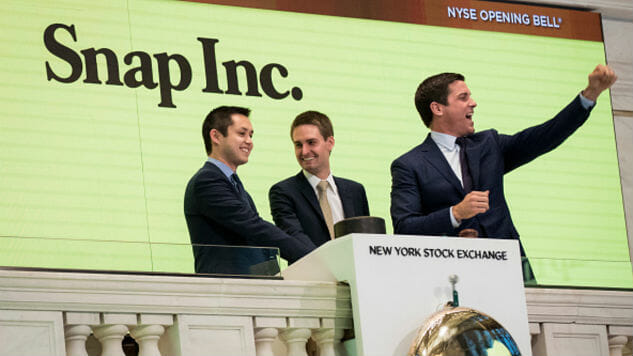Snap’s IPO Was a Success, but What They Do Next Is What Really Matters
Photos by Drew Angerer / Getty Images
The largest tech IPO since Facebook. That’s what all the headlines have been saying this week after Snap, the parent company of Snapchat, went public on the New York Stock Exchange.
By all accounts the IPO was a success, despite several concerns. Earlier in the week, Snap had priced the IPO at $17 per share but when trading commenced it opened at a generous $24 and ended the day at $24.48. The flotation raised $3.4 billion, valuing the company and image sharing app at around $28 billion, though investors have no voting rights.
Much had been made of the company’s valuation over the last few weeks after Snap published its S-1 filing, which laid out the state of the company ahead of the flotation. Original estimates between $20 billion and $25 billion were bandied around but at one point the valuation was believed to be as low at $19 billion in response to concerns over the app’s monetization plans. A lower valuation was seen as a more cautious route in case things didn’t exactly work out. Snap CEO Evan Spiegel and his co-founder Bobby Murphy, who both still own a considerable majority of shares, didn’t want to go the way of so many tech IPOs by over-promising.
Tech IPOs are famously rocky. Facebook’s IPO in 2012 was a pivotal moment for its generation of Silicon Valley darlings but it overstretched at first, pricing its shares at $42 and from there plummeted. It has of course rebounded several times over since then. Twitter on the other hand has been rustled many times since it went public in 2013 and now stands at less than half the value it was at the time of the IPO.
Snap’s eventual IPO has been the subject of speculation for years with investors and analysts picking apart its user growth and operating costs. While Thursday’s IPO was a winner, the follow-through is everything.
It is not out of the woods; far from it. Worries abound about how the company will execute its future money making strategies through advertising and partnerships and how it will continue to grow its user base.

Latest figures show that the app has over 150 million active daily users but this growth was slowing down after a period of acceleration. Just ask Twitter how slow user growth can spook investors. Snapchat on the other hand has one key tool in its belt, it has a large user base of teenagers—a user market that Facebook and Twitter wish it could tap into in the same way.
During its investor roadshow over the last few weeks, Snapchat was tasked with convincing investors that it would not endure the same fate as Twitter and that it has plenty of new tactics ahead for monetization.
-

-

-

-

-

-

-

-

-

-

-

-

-

-

-

-

-

-

-

-

-

-

-

-

-

-

-

-

-

-

-

-

-

-

-

-

-

-

-

-









































